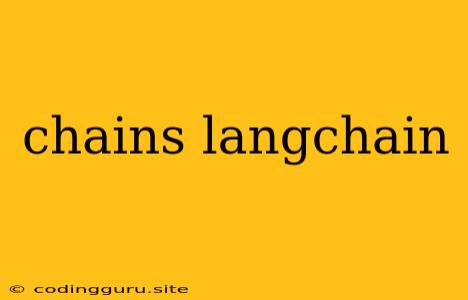Demystifying the Power of Chains in LangChain: Building Powerful Language Models
In the ever-evolving world of artificial intelligence (AI), large language models (LLMs) have emerged as a transformative force, capable of understanding and generating human-like text with remarkable fluency. However, harnessing the full potential of LLMs for real-world applications often requires more than just basic text processing. This is where LangChain, a powerful and versatile framework, comes into play.
LangChain offers a robust toolkit for building sophisticated language-based applications by enabling developers to seamlessly connect and orchestrate various components, including LLMs, data sources, and other tools. One of the most compelling features of LangChain is its concept of chains, which serve as building blocks for creating complex, multi-step workflows.
What are Chains in LangChain?
Chains in LangChain are essentially sequences of interconnected components that work together to achieve a specific task. Think of them as pipelines or workflows that automate complex processes involving language models. Each chain consists of multiple "links," which can represent LLMs, prompts, memory mechanisms, data retrieval modules, and other essential elements.
For example:
Imagine you want to build a chatbot that answers questions about a specific topic. You might use a "RetrievalQA" chain which retrieves relevant information from a knowledge base and then uses an LLM to generate a concise and informative response. This chain would consist of:
- A retrieval component: To fetch information from your knowledge base (e.g., a document store or database).
- An LLM component: To process the retrieved information and craft a coherent response.
Why are Chains Useful?
The beauty of chains lies in their ability to combine different functionalities into a single, cohesive unit. This modularity and flexibility allow you to:
- Simplify complex workflows: Instead of manually managing individual components, you can encapsulate entire sequences of operations within chains, making your code cleaner and easier to maintain.
- Promote reusability: Once you've defined a chain for a specific task, you can reuse it in various applications without needing to reimplement the entire logic.
- Enable modular development: Chains encourage a modular development approach, where different teams can focus on building individual chains for specific tasks, ultimately contributing to a larger application.
Types of Chains in LangChain
LangChain offers a wide range of pre-built chains for common language-based tasks. Here are some key examples:
- RetrievalQA: This chain retrieves relevant information from a knowledge base and uses an LLM to generate a concise answer to a user's query.
- ConversationChain: This chain facilitates a multi-turn conversation with an LLM, maintaining context across different user interactions.
- SummarizationChain: This chain uses an LLM to summarize a given text, providing a condensed overview of the content.
- TranslationChain: This chain translates text between different languages using an LLM as a translator.
- Chain of Thought: This chain encourages LLMs to explain their reasoning process by generating a series of intermediate thoughts before arriving at a final answer.
Building Your Own Chains
LangChain makes it incredibly easy to build custom chains tailored to your specific needs. You can combine pre-built chains, define new chains from scratch, or modify existing ones.
Here's a simple example of how to build a chain that summarizes a given text:
from langchain.chains import SummarizationChain
from langchain.llms import OpenAI
llm = OpenAI(temperature=0.7) # Use OpenAI LLM for summarization
chain = SummarizationChain(llm=llm, chain_type="map_reduce")
text = "This is a very long text that needs to be summarized."
summary = chain.run(text)
print(summary)
In this example, we create a SummarizationChain using an OpenAI LLM. The chain uses the map_reduce technique to effectively summarize the given text.
Advanced Chain Features
LangChain empowers you to build even more advanced chains by utilizing its various features:
- Memory: You can incorporate memory mechanisms into chains to store and retrieve previous interactions, enabling more context-aware and personalized responses.
- Callbacks: Chains allow you to register callbacks to track progress, monitor performance, and handle errors during execution.
- Tracing: LangChain provides tracing capabilities to visualize the flow of data and execution steps within your chains, aiding in debugging and analysis.
Conclusion
LangChain is a powerful and versatile framework that revolutionizes the way we build language-based applications. By leveraging the concept of chains, developers can create modular, reusable, and efficient workflows that harness the full potential of LLMs for various tasks, ranging from simple question answering to complex conversational AI systems. As the AI landscape continues to evolve, LangChain will undoubtedly play a crucial role in enabling the next generation of language-based applications.
